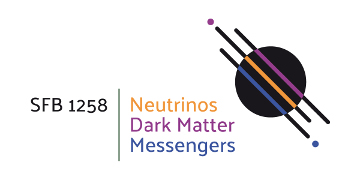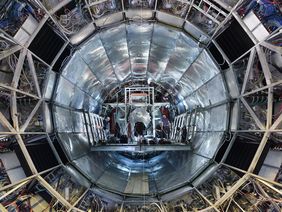Dark matter is thought to account for approximately 80% of the matter density and 25% of the energy density in the universe. Although there are strong indications for its existence from various gravitational observations, dark matter has so far escaped direct detection. The ongoing quest for dark matter ranges from direct searches for Weakly Interacting Massive Particles (WIMPS), the class of particles currently favored as dark matter candidates, to indirect searches where possible annihilation or decay signals from dark matter are explored.
Annihilation signals form dark matter
The presence of antimatter particles could be interpreted as dark matter annihilation signal, but since antimatter is also expected from high-energy cosmic ray interactions with the interstellar medium, the evidence would be ambiguous. Some dark matter models predict that low-energy anti-deuterons are a promising probe for indirect dark matter searches because the contributions resulting from cosmic ray interactions with the interstellar medium are expected to be small at low energies. Several experiments on satellites or balloons are currently searching for anti-deuteron and anti-helium, but no clear evidence for anti-nuclei production has been found yet.
Low-energy anti-deuterons as a probe for indirect dark matter searches
In order to interpret any future observation of anti-nuclei in our galaxy as a dark matter signal, the anti-nuclei production and the annihilation within the interstellar medium must be quantitatively understood, because this strongly affects the expected antimatter flux near the Earth.
On Earth, the anti-nuclei production and the interaction with ordinary matter can be studied using the Large Hadron Collider (LHC) as an antimatter generator and the ALICE experiment as an antimatter detector.
Analyses of the anti-deuteron yield in p-p collisions
Anti-nuclei at the LHC are produced in collisions of protons (p-p) or protons with heavy nucleons such as lead (p-Pb) at velocities close to the speed of light. In collisions of protons with lead nuclei, anti-deuterons are generated at great number, but in proton-proton collisions the rates are smaller such that there exist only few detailed measurements. The ALICE collaboration has now conducted a comprehensive analysis of this production path using a recently collected large data sample. They found that, within the uncertainties, the anti-deuteron yield in p-p collisions resembles the one in p–Pb interactions, suggesting a common formation mechanism. The results also provide strong constraints on the production models which are of great importance for the prediction of the anti-nuclei flux in space.
First measurement of the anti-deuteron inelastic cross section
The ALICE Collaboration has recently performed also the first measurement of the anti-deuteron inelastic cross section at low energy, that quantifies the probability of anti-deuteron annihilation in collisions with matter (atomic nuclei). To this purpose, the number of observed anti-deuterons is compared to the number of observed deuterons, that do not annihilate in the material. The momentum range covered in this measurement is of particular relevance for a dark matter signal interpretation in Space. Additionally, these measurements help understanding the low-energy antimatter-matter annihilation processes.
CERN Press release: Fresh antimatter study by ALICE collaboration will help with the search for dark matter
Original publications
ALICE collaboration: (Anti-)Deuteron production in pp collisions at √ s = 13 TeV, CERN 3 March 2020
ALICE Collaboration: Measurement of the low-energy antideuteron inelastic cross section, CERN, 14 May 2020
Contact
Prof. Laura Fabbietti
Technical University of Munich
Physics Department
E-Mail: laura.fabbietti@ph.tum.de
Dr. Ivan Vorobyev
Technical University of Munich
Physics Department
E-Mail: ivan.vorobyev@cern.ch
Dr. Maximiliano Puccio
CERN
E-Mail: maximiliano.puccio@cern.ch



